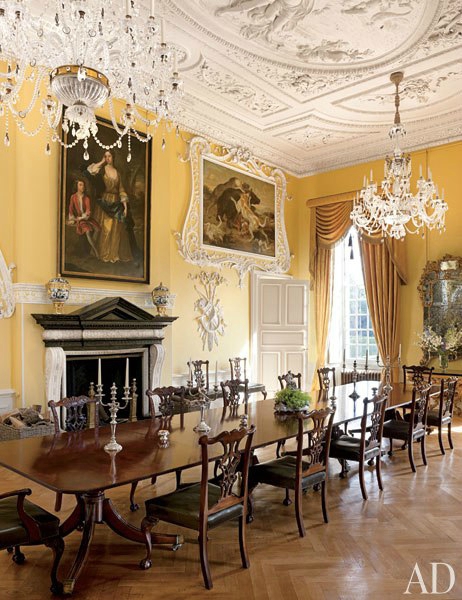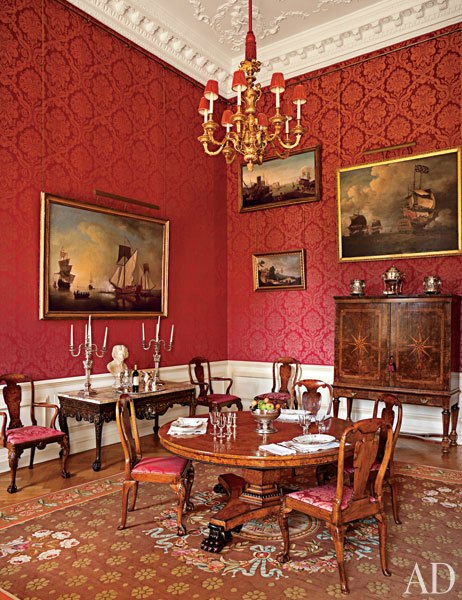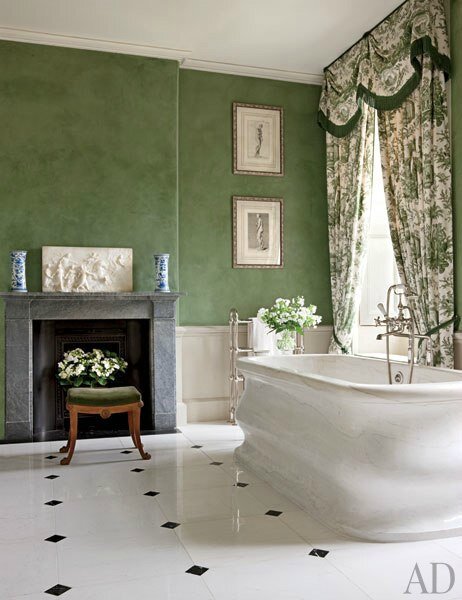Easton Neston Revived
The east façade of Easton Neston, in Northamptonshire, England. The 1702 house by Nicholas Hawksmoor is owned by fashion designer Leon Max, who restored it with Ptolemy Dean Architects and Spencer-Churchill Designs.
Max at ease in the library, which was created in 1967 by architect Roderick Gradidge and designer David Hicks.
In the drawing room, the painting over the mantel is from the school of Sir Peter Paul Rubens; the canvases on the far wall are by Luca Giordano (top) and Enoch Seeman. The George II marble-top mahogany table hosts 19th-century Chinese jars. The carpet is a 19th-century Aubusson.
Circa-1800 French riverscapes share the garden hall with antique marble busts depicting the four seasons; the painted benches were designed in the manner of 18th-century British architect William Kent.
The Yellow Dining Room’s ornate stuccowork dates from the 1730s; the marble mantel is by William Kent, and the chandeliers, mahogany table, and curtain fabric were custom made. The portrait of the first Duchess of Grafton and her son is by Sir Godfrey Kneller, and the hunting scene is attributed to Paul de Vos.
The Red Dining Room features a Regency pedestal table surrounded by circa-1860 chairs in the Queen Anne style. Seascapes by 18th-century British artist Samuel Scott overlook an Irish Georgian mahogany table and a Dutch Baroque cabinet-on-stand. The ormolu chandelier is 19th-century French, the walls are covered in a custom-made silk-wool damask copied from an 18th-century document, and the carpet is a circa-1840 Aubusson.
Architect Ptolemy Dean restored the vaulted basement to its late-17th-century glory and made it the primary kitchen.
Graced with a wrought-iron balustrade, the Great Staircase ascends from a hall outfitted with Georgian antiques, Italian Renaissance statuary, and paintings by, among others, 17th-century artist Sir Peter Lely and his studio. On the gilt-wood table stands a pair of Louis-Philippe oil lamps.
The master bedroom is dominated by a majestic 17th-century Brussels tapestry by Geraert van der Strecken; a late-19th-century Chinese embroidered-silk coverlet dresses the gilt-wood bed. The parcel-gilt armchairs are by ébéniste Jean-Baptiste-Claude Séné, and the table and side chairs are 18th-century Italian; the carpet is a Louis XVI Aubusson.
A 17th-century Gobelins scene from the life of King Solomon is displayed in the sitting room of the master suite.
An 18th-century grisaille painting hangs in the master bath; the tub fittings are by Lefroy Brooks.
The Tapestry Bedroom features a George III mahogany bed with a custom-printed linen canopy; the carpet is a 19th-century Sultanabad.
The German Bedroom, named for the origin of its furnishings, includes an 18th-century marquetry bed, a gilt-wood mirror, and a circa-1800 cylinder desk. The bed hangings, in a Marvic print, are lined with a Brunschwig & Fils check.
The bath of the Empress Suite—named in honor of Empress Elisabeth of Austria, who rented Easton Neston in 1876—is anchored by a marble tub with Lefroy Brooks fittings.
Reportedly designed in the late 17th century by Sir Christopher Wren, the redbrick wing houses Max’s design studio.
Stone columns crowned with 19th-century statues flank a gravel walk in the gardens.
Topiary lends sculptural presence to the grounds.
The vista from a second-floor window takes in an ornamental pool ringed by clipped hedges and, in the distance, an 800-yard-long canal. Reportedly designed in the late 17th century by Sir Christopher Wren, the redbrick wing houses Max’s design studio.

/https%3A%2F%2Fprofilepics.canalblog.com%2Fprofilepics%2F1%2F0%2F100183.jpg)
/https%3A%2F%2Fstorage.canalblog.com%2F03%2F02%2F119589%2F96711876_o.jpg)
/https%3A%2F%2Fstorage.canalblog.com%2F11%2F31%2F119589%2F94773502_o.jpg)
/https%3A%2F%2Fstorage.canalblog.com%2F20%2F83%2F119589%2F94772815_o.jpg)
/https%3A%2F%2Fstorage.canalblog.com%2F26%2F72%2F119589%2F75604929_o.jpg)
/https%3A%2F%2Fstorage.canalblog.com%2F59%2F60%2F119589%2F26458628_o.jpg)




















/image%2F1371349%2F20240425%2Fob_c453b7_439605604-1657274835042529-47869416345.jpg)
/image%2F1371349%2F20240425%2Fob_59c6f0_440358655-1657722021664477-71089985267.jpg)
/image%2F1371349%2F20240425%2Fob_07a28e_440353390-1657720444997968-29046181244.jpg)
/image%2F1371349%2F20240425%2Fob_0b83fb_440387817-1657715464998466-20094023921.jpg)